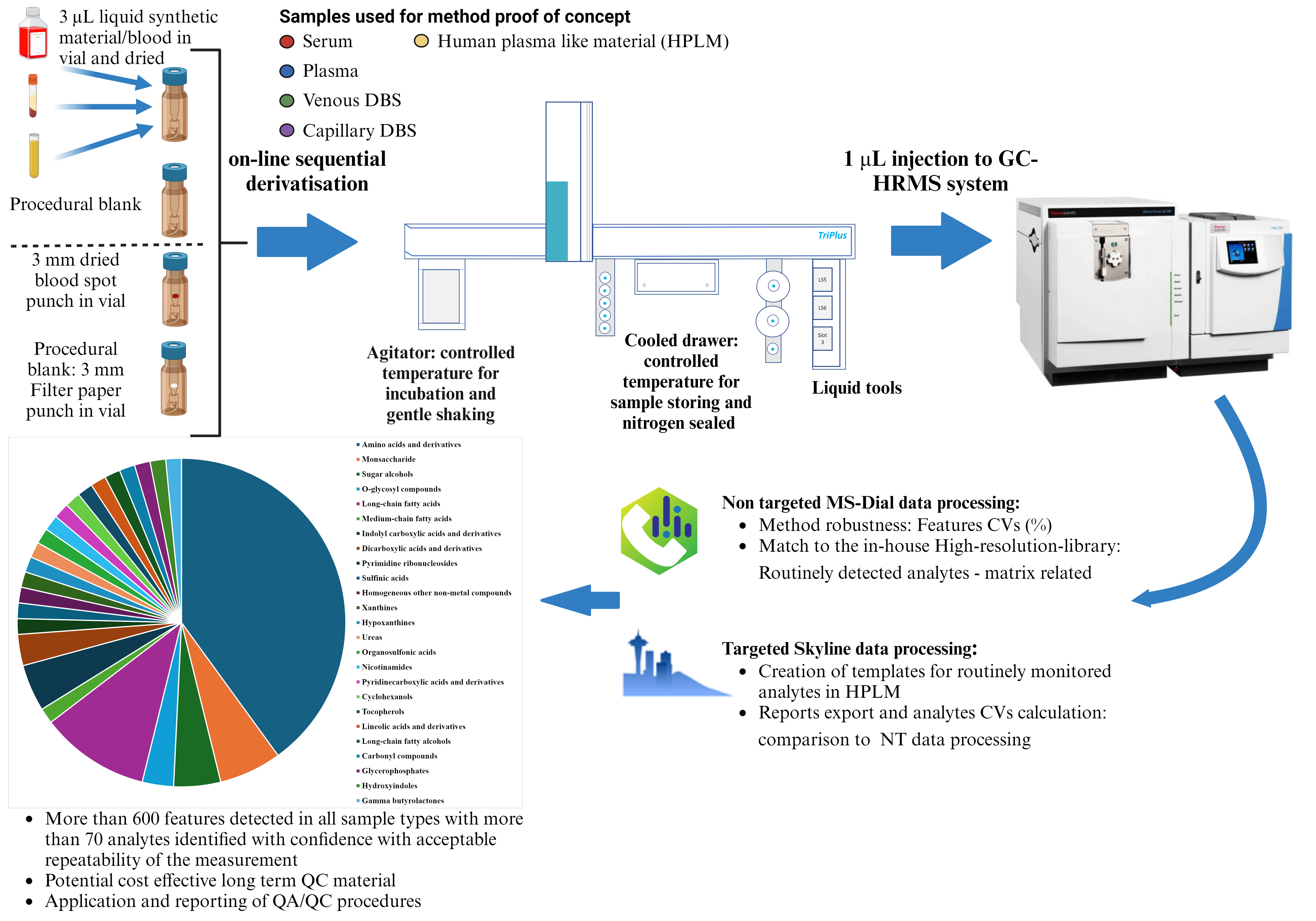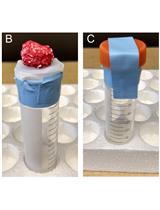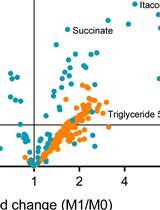- EN - English
- CN - 中文
Automated Sequential Derivatization for Gas Chromatography-[Orbitrap] Mass Spectrometry-based Metabolite Profiling of Human Blood-based Samples
基于气相色谱-[Orbitrap] 质谱的人血样本代谢物分析的自动化顺序衍生化方法
发布: 2025年03月05日第15卷第5期 DOI: 10.21769/BioProtoc.5196 浏览次数: 2247
评审: Amit Kumar DeyJoyce ChiuAnonymous reviewer(s)
Abstract
Many small molecules require derivatization to increase their volatility and to be amenable to gas chromatographic (GC) separation. Derivatization is usually time-consuming, and typical batch-wise procedures increase sample variability. Sequential automation of derivatization via robotic liquid handling enables the overlapping of sample preparation and analysis, maximizing time efficiency and minimizing variability. Herein, a protocol for the fully automated, two-stage derivatization of human blood–based samples in line with GC–[Orbitrap] mass spectrometry (MS)-based metabolomics is described. The protocol delivers a sample-to-sample runtime of 31 min, being suitable for better throughput routine metabolomic analysis.
Key features
• Direct and rapid methoximation on vial followed by silylation of metabolites in various blood matrices.
• Measure ~40 samples per 24 h, identifying > 70 metabolites.
• Quantitative reproducibility of routinely measured metabolites with coefficients of variation (CVs) < 30%.
• Requires a Thermo ScientificTM TriPlusTM RSH (or comparable) autosampler equipped with incubator/agitator, cooled drawer, and automatic tool change (ATC) station equipped with liquid handling tools.
Keywords: Automation (自动化)Graphical overview

Workflow for profiling metabolites in human blood using automated derivatization
Background
Gas chromatography–mass spectrometry (GS–MS)-based blood metabolite profiling is an established biochemical technique to investigate human disease and treatment response [1,2], being scalable to large epidemiological studies [3]. Most analysis is conducted on plasma and serum routinely collected in clinical settings, but the use of dried blood spots is prevalent for newborn screening [4] and forensic toxicology, increasingly being collected outside clinical settings for population studies [5].
Once samples are in the lab, sample preparation often constitutes more than 60% of total analytical time [6,7], representing the major bottleneck of throughput. Manual handling during sample preparation contributes to higher bias, with increasing sample-to-sample variation that affects the results and biological interpretation [8].
Derivatization is often employed to make polar non-volatile compounds amenable to GC–MS analysis [9,10]. In human studies, the most used derivatization method for the detection of metabolites is methoximation followed by silylation. Methoximation stabilizes the carbonyl group of, e.g., reducing sugars, whilst silylation acts upon a diversity of functional groups (alcohols, carboxylic acids, amines, thiols, and phosphates), enabling the detection of a broad range of metabolites. Additionally, available electron ionization (EI) MS libraries comprise a high proportion of spectra for trimethylsilyl (TMS) derivatives [11,12] to aid annotation.
However, classical batch-wise derivatization approaches often lead to high sample variability, particularly because of the differing length of time following derivatization until injection. Notably, many derivatization reactions do not have a defined endpoint, and derivatives are often unstable. Furthermore, many analytes form multiple derivatives and isomers [13,14], complicating comparative quantification due to inconsistent ratios of different derivative forms.
To overcome the variability of batch-wise derivatization, procedures for automated, sequential derivatization for human plasma GC–MS metabolomics have been described [15,16]. However, both reported applications had relatively long GC runtimes (>40 min) and sample-to-sample runtimes of ~1 h or more. Additionally, their application was not demonstrated for other blood matrices.
Herein, we describe an automated method for the methoximation-silylation derivatization of metabolites for the sequential, online GC-[Orbitrap] MS-based metabolite profiling of various dried blood matrices, i.e., dried blood spots of capillary and venous blood, dried serum and plasma, and synthetic blood. The sequential sample preparation standardizes the time from derivatization to sample injection, increasing robustness over batch-wise procedures [17], and provides reproducible measurements of ~70 confirmed metabolites per sample with a throughput of ~45 injections per 24 h.
Materials and reagents
Biological materials
1. Dried capillary blood spots (DBS capillary): Capillary blood was collected using a lancet from the finger and spotted onto Whatman 903 protein saver cards [18]. DBS-capillary spots were dried for 12 h at 20 °C in a fume hood. Dried spots were covered with aluminum foil, placed in a zip-lock bag with silica bags to absorb moisture, and stored at -80 °C
2. Dried venous blood spots (DBS venous): Venous blood was collected via S-Monovette® neutral Z (Sarstedt, catalog number: 04.1926.001) [18]. DBS-venous spots were made by dispensing 100 μL onto collection cards following the same procedure as for DBS capillary
3. Gibco human plasma-like material (HPLM) (Thermo Scientific, catalog number: A4899101)
4. Pooled human serum: Mixture of serum derived from patients of University Hospital Brno
5. Pooled human plasma: Mixture of plasma derived from patients of University Hospital Brno
Reagents
1. Chloroform (Sigma-Aldrich, catalog number: 65049)
2. Isooctane (Sigma-Aldrich, catalog number: 32291-M)
3. Methanol (Biosolve, catalog number: 136841)
4. Hexane (J.T. Baker, catalog number: 5274.2500)
5. Methoxylamine hydrochloride (Thermo Scientific, catalog number: A19188)
6. N-Methyl-N-trimethylsilyltrifluoroacetamide (MSTFA), ≥98.5% (Sigma-Aldrich, catalog number: 69479-25ML)
7. Pyridine anhydrous, 99.8% (Sigma-Aldrich, catalog number: 270970-100ML)
8. Acetone, ≥99.5% (J.T. Baker, catalog number: 15548454)
9. C7-C40 saturated alkanes standard, certified reference material (CRM) (MilliporeSigmaTM SupelcoTM, catalog number: 11-101-7207)
10. Fully resolved native Mono-Deca PCB mixture (unlabeled) (Cambridge Isotope Laboratories, Inc., catalog number: EC-5434)
11. D7-cholesterol, >99% (Sigma-Aldrich, catalog number: 700041P-10MG)
12. D5-glycine, 99% (Sigma-Aldrich, catalog number: 175838-5G)
13. D27-myristic acid, 99% (Sigma-Aldrich, catalog number: 366889-1G)
Solutions
1. C7-C40 alkanes solution (1 μg/mL) (see Recipes)
2. Mono-Deca PCBs solution (100–200 ng/mL) (see Recipes)
3. D7-Cholesterol stock solution (100 μg/mL) (see Recipes)
4. D5-Glycine stock solution (100 μg/mL) (see Recipes)
5. D27-Myristic acid stock solution (100 μg/mL) (see Recipes)
6. Internal standard mix (IS mix, 1.6 μg) (see Recipes)
7. Methoximation solution (MeOx, 15 mg/mL, 1 μg/mL ISs) (see Recipes)
8. MSTFA working solution (see Recipes)
Recipes
1. C7-C40 alkanes solution (1 μg/mL)
The CRM C7-C40 saturated alkanes standard contains each alkane at 1,000 μg/mL in hexane. The mixture is diluted in isooctane to achieve a final concentration of 1 μg/mL per each alkane component in a 1 mL final solvent volume. Stored at -20 °C, the solution should be stable for up to a year. However, due to multiple freeze-thaw cycles, we recommend preparing fresh solution every 6 months.
2. Mono-Deca PCBs solution (100–200 ng/mL)
The fully resolved native Mono-Deca PCB mixture (unlabeled) is composed of components at 1,000–2,000 ng/mL in isooctane. The mixture is diluted 10-fold to give a solution of components at 100–200 ng/mL in 1 mL of isooctane. Stored at -20 °C, the solution should be stable for up to a year. However, due to multiple freeze-thaw cycles, we recommend preparing fresh solution every 6 months.
3. D7-Cholesterol stock solution (100 μg/mL)
D7-Cholesterol stock solution (100 μg/mL) was prepared by dissolving 10 mg of D7-Cholesterol in 1 mL of chloroform, aliquoting 100 μL into 2 mL amber vials (i.e., 100 μg aliquots), and drying for 20 min via centrifugal evaporator operating the low boiling point (bp) program for solvents bp 60–100 °C, without light. Prior to use, 100 μg/mL stock solution is made by reconstitution in 1 mL of chloroform.
4. D5-Glycine stock solution (100 μg/mL)
D5-Glycine stock solution (100 μg/mL) is prepared by dissolving 10 mg of D5-Glycine in 1 mL of methanol, aliquoting 100 μL into 2 mL amber vials (i.e., 100 μg aliquots), and drying for 20 min via centrifugal evaporator operating the low boiling point (bp) program for solvents bp 60–100 °C, without light. Prior to use, 100 μg/mL stock solution is made by reconstitution in 1 mL of methanol.
5. D27-Myristic acid stock solution (100 μg/mL)
D27-Myristic acid stock solution (100 μg/mL) is prepared by dissolving 10 mg of D27-Myristic acid in 1 mL of chloroform, aliquoting 100 μL into 2 mL amber vials (i.e., 100 μg aliquots), and drying for 20 min via centrifugal evaporator operating the low boiling point (bp) program for solvents bp 60–100 °C, without light. Prior to use, 100 μg/mL stock solution is made by reconstitution in 1 mL of chloroform.
6. Internal standard mix (IS mix, 1.6 μg)
Internal standard mix is prepared by dispensing 16 μL of each prepared 100 μg/mL stock standard solution (D7-Cholesterol, D5-Glycine, and D27-Myritic acid) in 2 mL amber vials. The mix is evaporated to dryness via centrifugal evaporator using the same conditions as previously mentioned (~20 min, no light, and low bp program). Vials are capped with the bonded PTFE/silicone septum screw cap and stored at -80 °C.
Note: Each individual labeled standard stock solution and the IS mix listed above are stored dried at -80 °C; in our experience, they remain stable for >6 months. We recommend periodic monitoring by GC analysis to check stability.
7. MeOx solution (15 μg/mL, 1 μg/mL ISs)
A MeOx stock (15 μg/mL) is freshly prepared every two days via weighing 150 mg of methoxylamine hydrochloride into a 10 mL amber flat-bottom glass vial and dissolving in 10 mL of pyridine. For use, 1.6 mL of MeOx stock is dispensed into the IS mix vials (2–3), capped with pre-slit caps, and vortexed (10 s, 2,000 rpm) to give MeOx solution (15 μg/mL, 1 μg/mL ISs). MeOx solution (15 μg/mL, 1 μg/mL ISs) is placed in the cooled drawer of the autosampler with a controlled temperature at 5 °C and sealed under nitrogen.
8. MSTFA working solution
1.6 mL of MSTFA is dispensed in 2 mL amber vials (2–3) capped with bonded pre-slit PTFE/silicone septum screw caps and placed in the cooled drawer.
Laboratory supplies
1. 2 mL amber vial (Agilent, catalog number: 5190-9063)
2. Bonded PTFE/silicone septum screw cap (Agilent, catalog number: 5190-9068)
3. Magnetic cap Silicone/PTFE/starburst-slitted septa (PAL, catalog number: Cap-ND9-St-SP10Sb-100)
4. Glass amber vial with 0.2 mL integrated insert (MACHEREY-NAGEL, catalog number: 702008)
5. 10 mL amber flat bottom glass vial (JG Finneran, catalog number: 31018F-2346A) with Screw cap, solid top with PTFE liner (Supelco, catalog number: 27163)
6. Bonded pre-slit PTFE/silicone septum screw cap (Agilent, 5185-5824)
7. 0.1–10 μL epT.I.P.S. Reloads (Eppendorf, catalog number: 022491504)
8. 2–200 μL epT.I.P.S. Reloads (Eppendorf, catalog number: 022491733)
9. 50 μL–1 mL epT.I.P.S. Reloads (Eppendorf, catalog number: 022491555)
10. 0.5–10 mL epT.I.P.S. Standard (Eppendorf, catalog number: 022492098)
11. Labels for vials
12. Whatman 903 cards (Merck, catalog number: WHA10531018)
Equipment
1. 0.5–10 μL pipette (Eppendorf Research® plus, catalog number: 3123000020)
2. 20–200 μL pipette (Eppendorf Research® plus, catalog number: 3123000055)
3. 100–1,000 μL pipette (Eppendorf Research® plus, catalog number: 3123000063)
4. 1,000–10,000 μL pipette (Eppendorf Research® plus, catalog number: 3123000080)
5. 3 mm hole puncher
6. Centrifugal evaporator (SP Genevac EZ-2 Series centrifugal evaporator, model: 3.0, Elite)
7. Storage boxes for 2 mL vials (VWR, catalog number: 525-0934)
8. Mini vortex (Wizard D, catalog number: 444-0746)
9. AS X2 PLUS analytical balance (RADWAG, product code: WL-104-0191)
10. O-rings, Viton (Restek, catalog number: 22242)
11. Thermo ScientificTM TriPlusTM RSH with extended rail (Thermo, catalog number: 1R77010-0400)
12. Thermo Scientific OrbitrapTM ExplorisTM GC 240 mass spectrometer (Thermo, catalog number: BRE725537)
13. TriPlus RSH, automatic tool change (ATC) station (Thermo, catalog number: 1R77010-1019)
14. 2 TriPlus RSH, liquid tool: D7, 57 mm (Thermo, catalog number: 1R77010-1007)
15. Triplus RSH autosampler syringe 57 mm, 23 s Ga, cone, 100 µL (Thermo, catalog number: 365H2141)
16. TriPlus RSH autosampler syringe 57 mm, 23s Ga, cone, 10 µL (Thermo, catalog number: 365D0311)
17. TriPlus RSH, agitator/incubator (Thermo, catalog number: 1R77010-1032)
18. TriPlus RSH, temperature-controlled drawer: single (Thermo, catalog number: 1R77010-1028)
19. Topaz Liner, splitless, gooseneck. w/wool 4 mm × 6.3 × 78.5 (Restek, catalog number: 23303)
20. Merlin microseal (Restek, catalog number: 22812)
21. Rxi-5Sil MS, 0.25 μm, 0.25 mm ID low polarity phase, 15 m length, 0.25 mm ID, 0.25 μm film thickness (Restek, catalog number: 13620)
22. Rxi guard column phase free, 0.53 mm ID, 2 m length to inlet (Restek, catalog number: 10073)
23. Rxi guard column phase free, 0.25 mm ID, 2 m length to spectrometer (Restek, catalog number: 10059)
24. Tweezers
Software and datasets
1. Sampling Workflow Editor (SWE) (version 1.4.0.4)
2. Thermo Scientific Xcalibur (version 4.4.16.14, February 6, 2020)
3. Chromeleon 7.2.10
4. PALscript Editor (version 3.1 Beta)
5. EIRENE-CZ_RECETOX Metabolome high resolution–electron ionization–mass spectral library (HR-[EI+]-MS), free, CC-BY-NC, https://doi.org/10.5281/zenodo.5483565
6. MS-DIAL (version 4.9.221218), free, CC-BY 4.0, https://doi.org/10.5281/zenodo.12589462
7. Skyline (version 23.1.0.268), free, modified Apache 2.0 License, https://github.com/ProteoWizard/pwiz/tree/master/pwiz_tools/Skyline
8. Spreadsheet software, e.g., Microsoft Excel, Google Sheets (free under Google terms of service)
9. BioRender (https://www.biorender.com/). The following figures were created using BioRender: Graphical overview, https://BioRender.com/v67e825; Figure S1, https://BioRender.com/y04y703
Procedure
文章信息
稿件历史记录
提交日期: Sep 12, 2024
接收日期: Dec 12, 2024
在线发布日期: Jan 8, 2025
出版日期: Mar 5, 2025
版权信息
© 2025 The Author(s); This is an open access article under the CC BY license (https://creativecommons.org/licenses/by/4.0/).
如何引用
Jbebli, A., Coufalíková, K., Zanaboni, M., Bergna, M., Picenoni, R., Klánová, J. and Price, E. J. (2025). Automated Sequential Derivatization for Gas Chromatography-[Orbitrap] Mass Spectrometry-based Metabolite Profiling of Human Blood-based Samples. Bio-protocol 15(5): e5196. DOI: 10.21769/BioProtoc.5196.
分类
系统生物学 > 代谢组学 > 生物流体
生物化学 > 其它化合物
您对这篇实验方法有问题吗?
在此处发布您的问题,我们将邀请本文作者来回答。同时,我们会将您的问题发布到Bio-protocol Exchange,以便寻求社区成员的帮助。
Share
Bluesky
X
Copy link












